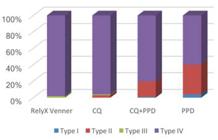Abstract
The goal of this study was to evaluate in vitro the effect of the photoinitiator phenylpropanedione (PPD), alone or combined with camphorquinone (CQ), on color stability of photoactivated resin cements and their bond strength to ceramics using a micro-shear test. Four resin cements were used: a commercial brand cement (RelyX Veneer®) and 3 experimental cements with different types and concentration of photoinitiators. For color analysis, ceramic discs were cemented on bovine dentin specimens to simulate indirect restorations (n=8) and were exposed to UV for 120 h and tested for color alteration using a reflectance spectrophotometer and the CIEL*a*b* system. Data were analyzed by Anova and Tukey’s test at 5% significance level. The color test results did not present statistically significant difference for the ∆E for all the studied cements, neither for ∆L, ∆a and ∆b. For the bond strength, all the studied cements showed statistically significant differences to each other, with the highest result for the RelyX Veneer® (29.07 MPa) cement, followed by the cement with CQ (21.74 MPa) and CQ+PPD (19.09 MPa) cement; the lowest result was obtained by the cement using only PPD as a photoinitiator (13.99 MPa). So, based on the studied parameters, PPD was not advantageous as photoinitiator of resin cements, because it showed a low value of bond strength to the ceramics and no superior color stability.
Key Words:
photoinitiator; cements; colors; bond strength

 Thumbnail
Thumbnail
 Thumbnail
Thumbnail

